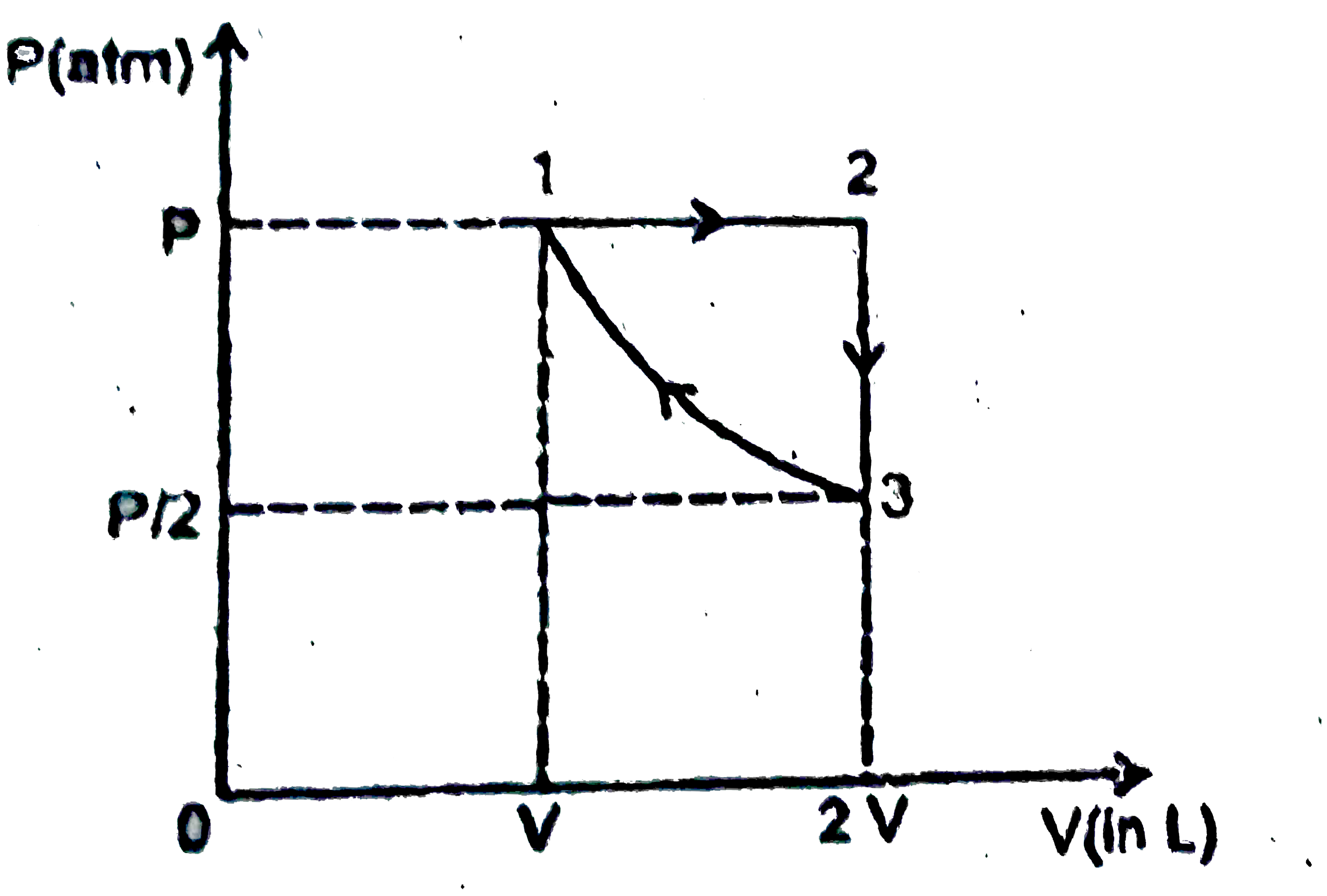Two moles of a perfect gas undergo the following processes:
a. A reversible isobaric expansion from (1.0atm,20.0L) to (1.0atm,40.0L).
b. A reversible isochroic change of state from (1.0atm,40.0L) to (0.5atm,40.0L)
c. A reversible isothermal expansion from (0.5atm,40.0L)→(1.0atm,20.0L).
i. Sketch with lables each of the processes on the same P−V diagram.
ii. Calculate the total work (w) and the total heat change (q) involved in the above process.
iii. What will be the values of ΔH for the overall process?
AB→Isobaric process
BC→ Isochoric process
CA→ Isothermal compression

Total work =wAB+wBC+wCA ltbr> =−P×ΔV+0+2.303nRT log (V2V1)
=−1×20×101.3+0+2.303×2×8.314×T log (4020) . . .(i)
PV=nRT (At A)
1×20=2×0.082×T
T=202×0.0821=121.8K
From eq. (i)
Total work=−2026+2.303×2×8.314×121.8 log 2
=−622.06J
w=q=−622.06J
In cyclic process, ΔU=0,ΔH=0andΔS=0.
Topper's Solved these Questions
- Chemical Thermodynamics and ThermochemistryBook:OP TANDONChapter:Chemical Thermodynamics and ThermochemistryExercise:Practice problems
Explore 81 Videos
- Chemical Thermodynamics and ThermochemistryBook:OP TANDONChapter:Chemical Thermodynamics and ThermochemistryExercise:Objective Question Level-A
Explore 177 Videos
- Chemical Thermodynamics and ThermochemistryBook:OP TANDONChapter:Chemical Thermodynamics and ThermochemistryExercise:Illustrations of Objective Questions
Explore 58 Videos
- CHEMICAL KINETICSBook:OP TANDONChapter:CHEMICAL KINETICSExercise:LINKED COMPRESHENSION TYPE QUESTIONS ( SECTION-VI)
Explore 4 Videos
- CLASSIFICATION AND NOMENCLATURE OF ORGANIC COMPOUNDS Book:OP TANDONChapter:CLASSIFICATION AND NOMENCLATURE OF ORGANIC COMPOUNDS Exercise:INTEGER
Explore 2 Videos
Similar Questions
Two moles of a perfect gas undergo the following processes:
a. A reversible isobaric expansion from (1.0atm,20.0L) to (1.0atm,40.0L).
b. A reversible isochroic change of state from (1.0atm,40.0L) to (0.5atm,40.0L)
c. A reversible isothermal expansion from (0.5atm,40.0L)→(1.0atm,20.0L).
i. Sketch with lables each of the processes on the same P−V diagram.
ii. Calculate the total work (w) and teh total heat change (q) involved in the above process.
iii. What will be the values of ΔG and ΔH for the overall process?
View SolutionTwo moles of a perfect gas undergo the following process: (a) A reversible isobaric expansion from (1.0 atm, 20.0 litre) to (1.0 atm,40.0litre). (b) A reversible isochoric change of state from (1.0 atm, 40.0 litre) to (1.0 atm, 40.0 litre). (b) A reversible isochoric change of state from (1.0 atm, 40.0 litre) to (0.5 atm, 40.0 litre). (c) A reversible isothermal compression from (0.5atm, 40.0 litre) to (1.0 atm, 20.0 litre). (i) Sketch with labels each of the process on the same P−V diagram. (ii) Calculate the total work (W) and the total heat change (q) involved in the above process. (iii) What will be the value of ΔU,ΔH and ΔS for the overall process?
View Solution
Knowledge Check
Two moles of an ideal gas undergo the following process :
(a) a reversible isobaric expansion from (P atm, VL) to (P atm , 2VL).
(b) a reversible isochoric change of state from (P atm , 2V,L) to (P/2 atm, 2VL)
(c) a reversible isothermal compression from (P/2 atm, 2VL) to (P atm, VL).
Sketch with labels each of the processes on the same P−V diagram.A B
B C
C D
D
Maximum heat absorbed during isothermal expansion of an ideal gas from (10 atm, 1 L) to (1 atm, 10 L) is :
A90 atm-LB10 atm-LC9 atm-LD23.03 atm-LOne mole of non - ideal gas undergoes a change of state (2.0 atm , 3 .0 L , 95 K → (4.0 atm , 5.0 L , 245 K) with a change in internal energy , ΔU=30.0L atm . The change in enthalpy (ΔH) of the process in L atm is
A40B42.3C44DNot defined, because pressure is not constant
Two moles of a perfect gas undergo the following processes :
(a) a reversible isobaric expansion from (1.0 atm, 20.0 L) to (1.0 atm, 40.0 L)
(b) a reversible isochoric change of state from (1.0 atm, 40.0 L) to (0.5 atm, 40.0 L)
(c ) a reversible isothermal compression from (0.5 atm, 40.0 L) to (1.0 atm, 20.0 L)
(i) Sketch the labels of each of the processes on the same p-V diagram.
(ii) Calculate the total work (W) and the total heat change (q) involved in the above processes.
(iii) What will be the values of ΔU,ΔH and ΔS for the overall process ?
View SolutionTwo moles of a perfect gas undergo the following processes:
a. A reversible isobaric expansion from (1.0atm,20.0L) to (1.0atm,40.0L).
b. A reversible isochroic change of state from (1.0atm,40.0L) to (0.5atm,40.0L)
c. A reversible isothermal expansion from (0.5atm,40.0L)→(1.0atm,20.0L).
i. Sketch with lables each of the processes on the same P−V diagram.
ii. Calculate the total work (w) and the total heat change (q) involved in the above process.
iii. What will be the values of ΔH for the overall process?
View SolutionTwo moles of a perfect gas undergo the following processes:
(a) a reversible isobaric expansion from (1.0 atm , 20.0 L) to (1.0 atm, 40.0 L)
(b) a reversible isochroic change of state from (1.0 atm , 40.0L) to (0.5 atm , 40.0 L)
(c) a reversible isothermal compression from (0.5 atm,40.0 L ) to (1.0atm, 20.0L)
Calculate the magnitude of work (W) done in L.atm
View SolutionTwo moles of a perfect gas undergo the following process: (a) A reversible isobaric expansion from (1.0 atm, 20.0 litre) to (1.0 atm,40.0litre). (b) A reversible isochoric change of state from (1.0 atm, 40.0 litre) to (1.0 atm, 40.0 litre). (b) A reversible isochoric change of state from (1.0 atm, 40.0 litre) to (0.5 atm, 40.0 litre). (c) A reversible isothermal compression from (0.5atm, 40.0 litre) to (1.0 atm, 20.0 litre). (i) Sketch with labels each of the process on the same P−V diagram. (ii) Calculate the total work (W) and the total heat change (q) involved in the above process. (iii) What will be the value of ΔU,ΔH and ΔS for the overall process?
View SolutionOne mole of an ideal gas undergoes a change of state (2.0) atm, 3.0 L) to (2.0 atm, 7.0 L) with a change in internal energy (ΔU)=30 L-atm. The change in enthalpy (ΔH) of the process in L-atm :
View Solution

